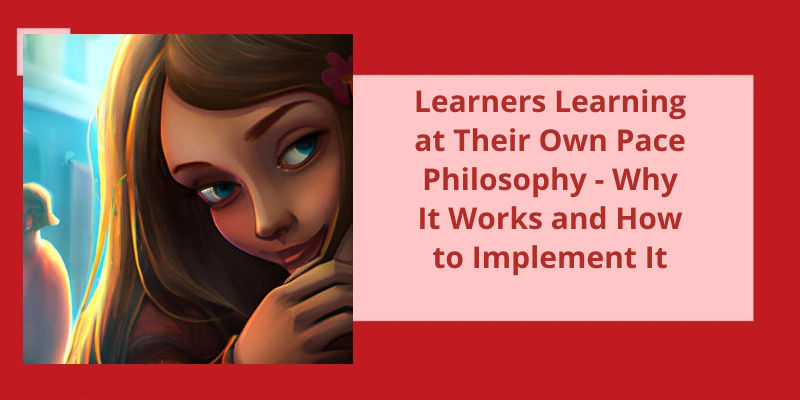The philosophy of learners learning at their own pace has been gaining popularity in recent times. Based on the principles of constructivism, this philosophy posits that students should be given the opportunity to uncover lessons through experimentation and hands-on activity. The belief is that this approach is the most effective way for students to truly learn as they’re able to connect new information with their existing knowledge and experiences, leading to a deeper understanding and retention of the content. Rather than being spoon-fed information, learners in this philosophy are encouraged to take ownership and responsibility for their own learning, resulting in a more engaged and motivated student body.
What Is the Philosophy of Learning by Doing by John Dewey?
One of John Deweys main beliefs is that education should be practical and relevant to real life situations. He felt that learning by doing was the most effective way for individuals to gain knowledge and understanding. For Dewey, learning was a continuous process that required active engagement with the environment. He believed that the classroom should be a place where students could explore, experiment, and learn from their mistakes.
Dewey also emphasized the importance of reflection in the learning process. He believed that by reflecting on their experiences, students could better understand the meaning behind their actions and use that knowledge to make informed decisions in the future. This approach to learning is often called experiential learning, as it involves using hands-on experiences to foster understanding.
One of the key benefits of learning by doing is that it allows students to develop practical skills that can be applied in real-world situations. This type of learning is particularly well-suited for fields such as science, technology, engineering, and mathematics (STEM), where hands-on experience is essential for success. By engaging with real-world problems, students can develop critical thinking, problem-solving, and decision-making skills that will serve them well in their future careers.
He believed that every individual had the potential to learn and grow, regardless of their background or socioeconomic status. This meant that education should be a tool for social change, helping to create a more equitable and just society.
Critiques or Limitations of Dewey’s Philosophy of Learning by Doing, Especially in the Context of Current Educational Systems
In Dewey’s philosophy of learning by doing, education is viewed as a process of active inquiry and experimentation where students learn by engaging in hands-on experiences. However, some critiques argue that this approach may not be practical in current educational systems as it prioritizes experiential learning over standardized testing and rote memorization, which are often the focus of traditional academic curricula. Additionally, some critics contend that a focus on “learning by doing” may marginalize students whose learning styles don’t align with this approach.
While there are numerous approaches to education, four major philosophical approaches dominate the global education system. These approaches focus on the curriculum aspect and answer the question of what we should teach. In this article, we’ll delve deeper into the core principles of each of the four education philosophies that are currently used in classrooms worldwide.
What Are the 4 Philosophy of Education?
Perennialism, the oldest of the four philosophies, is based on the belief that education should be centered on teaching the principles that have endured over time. Perennialists argue that these principles can be found in the works of great thinkers and authors from the past. The focus is on developing critical thinking skills and promoting a love of learning. Perennialists believe that knowledge is timeless and that students should be taught to think independently rather than just memorizing facts.
Essentialism is based on the belief that there are certain essential skills and knowledge that all students need to learn. Educators who subscribe to this philosophy prioritize reading, writing, mathematics, and science. The focus is on developing a broad range of skills that will be relevant to any career or path that the student chooses to pursue.
Progressivism is the philosophy that education should be focused on the needs and interests of the students. Teachers who subscribe to this philosophy believe that students learn best when they’re actively engaged in the learning process. Progressivists emphasize hands-on learning experiences and encourage students to pursue their passions. The goal is to create lifelong learners who’re curious and self-motivated.
Reconstructionism is a philosophy that views education as a means to create a better society. Reconstructionists argue that schools should be focused on solving social problems and promoting positive change. This philosophy is often associated with social activism and community involvement.
Overall, these four educational philosophies provide educators with different perspectives on how to approach teaching and learning. By understanding these different philosophies, educators can create more effective learning experiences that cater to the needs and interests of their students, while also preparing them for success in the future. It’s important to note that many educators combine elements of these philosophies to create a personalized approach to teaching that works best for their students.
Source: Educational Philosophies Definitions and Comparison Chart
In today’s era, the education system has been under a major transformation. Progressivism has been one of the dominating philosophies that focus on teaching the students how to think rather than what to think. This educational philosophy is based on the idea that the students should be actively involved in the learning process, and it should be an ongoing and collaborative experience for both students and teachers. Let’s dive deeper into the philosophy of progressivism education and understand it’s key aspects.
What Is the Philosophy of Progressivism Education?
Progressivism education advocates for the idea that education shouldn’t be a passive experience, but instead, a proactive one where students shouldn’t only be consumers of knowledge but also active producers who engage with the learning process. Progressivism emphasizes the importance of nurturing critical thinking and problem-solving skills among students. By encouraging students to participate actively in their learning process, they develop a sense of agency in their lives, and thus, become active agents of positive social change.
A central tenet of the progressivism philosophy is that education shouldn’t only prepare students for the future but also meet the needs of the present. Progressivism scholars believe that educational institutions should operate as a microcosm of the wider society to prepare students to participate actively in their communities. This means that institutions need to be responsive to the needs of the society and adjust their curricula and pedagogical approaches accordingly. For instance, institutions should instill values such as social justice, equality, democracy, and tolerance among students as these values are critical in building a just and cohesive society.
Scholars in progressivism argue that education should help students become aware of the social and political influences that shape their lives. Critical consciousness calls on students to develop an awareness of the systemic injustices that exist in their society, and to take an active role in fighting against them. By doing so, the education system can foster a generation of socially aware and active citizens who’re willing to work towards a better world.
By incorporating hands-on and interactive learning experiences, progressivist teachers aim to foster critical thinking skills, creativity, and problem-solving abilities in their students. This approach to education emphasizes the importance of relating classroom lessons to the real world and encourages students to take an active role in their own learning. Let’s examine some examples of how progressivism is put into practice in the classroom.
What Are Some Examples of Progressivism in the Classroom?
One example of progressivism in the classroom is incorporating project-based learning. In this approach, students are given a task or question to investigate and are expected to work collaboratively to find solutions. This approach encourages critical thinking, problem-solving, and creativity. By applying what they’ve learned to real-world scenarios, students can see the practical application of their education.
Progressivist teachers recognize that every student learns differently, and therefore, differentiate their instruction to meet the needs of individual students. By using a variety of teaching methods, such as visual aids, collaborative learning, and hands-on activities, students are able to better engage with the material and learn at their own pace.
Progressive classrooms also use technology to enhance the learning experience. The use of interactive whiteboards, iPads, and online resources can greatly improve the quality of education for students. These tools provide access to a wealth of information and can be used to create interactive and engaging lessons. Technology also allows for greater communication with parents and helps to keep them informed about their childs progress.
In a progressivist classroom, assessment is also approached differently. Rather than relying solely on traditional tests and quizzes, progressivist teachers use a variety of assessment methods, such as portfolios, exhibitions, and presentations. This approach allows for students to showcase their own learning in a way that’s meaningful and relevant to their own interests.
Lastly, progressivism in the classroom involves incorporating diversity and inclusivity into the curriculum. In todays increasingly diverse world, it’s important for students to learn about different cultures and perspectives. By including diverse voices and experiences in the curriculum, students can develop a better understanding and appreciation for the world around them. Progressivist teachers also create safe and inclusive classroom environments where all students feel valued and respected.
By incorporating project-based learning, differentiated instruction, technology, diverse perspectives, and alternative assessment methods, progressivist teachers create dynamic and inclusive classroom environments that promote critical thinking, creativity, and social development.
Now that we’ve a basic understanding of perennialism philosophy of education and it’s focus on timeless knowledge and critical thinking, let’s delve deeper into it’s key tenets and practical applications in the classroom.
What Is the Perennialism Philosophy of Education?
Perennialism philosophy of education is an approach to teaching that emphasizes the importance of timeless knowledge. This includes classic literature, historical events, and important scientific theories that continue to influence our society. The goal of perennialism is to teach students how to think critically and apply their knowledge to real-world problems.
Teachers focus on fundamental subjects like mathematics, science, literature, and history, rather than introducing trendy topics that may change over time. This approach helps students develop a solid foundation of knowledge that they can draw on throughout their lives.
This means that students learn to connect knowledge across a range of disciplines and time periods. They also learn how to analyze information critically, separate fact from fiction, and evaluate arguments using evidence-based reasoning.
Perennialism is sometimes criticized for being too focused on traditional knowledge and not enough on new and innovative ideas. However, proponents of perennialism argue that the ability to critically evaluate information is just as important as being exposed to new topics. And they believe that once students have a firm grasp of the foundational subjects, they’re better equipped to tackle new challenges and discover novel ideas.
This approach to education emphasizes traditional subjects like mathematics, science, literature, and history, and seeks to develop students ability to think rationally and analytically. In todays fast-changing and ever-evolving society, the skills that are taught in a perennialist classroom are more important than ever before.
Now that we’ve a basic understanding of progressivism philosophy in early childhood education, let’s delve deeper into how it can be applied in classrooms and the impact it can have on young learners. By prioritizing student needs and interests, progressivism can create a more engaging and interactive approach to education, potentially leading to better retention and understanding of concepts.
What Is Progressivism Philosophy in Early Childhood Education?
In early childhood education, progressivism encourages teachers to use child-centered approaches that prioritize a childs natural curiosity and desire to learn. This philosophy emphasizes the importance of hands-on learning experiences and encourages students to engage in activities that they find interesting and relevant to their lives.
This philosophy believes that children need to develop strong interpersonal skills, which they learn through collaboration and cooperation with others. Skills like empathy, communication, and conflict resolution are integral to a childs ability to succeed both in school and in life.
This means that teachers must listen to their students, encourage them to ask questions and seek answers, and provide opportunities for them to take ownership of their learning. By doing so, teachers can help children develop a lifelong love of learning that will stay with them throughout their lives.
This philosophy encourages teachers to create a supportive and nurturing learning environment that values the development of critical thinking skills, social and emotional skills, and active participation in the learning process. By embracing this philosophy, educators can help children develop a love of learning that will empower them to succeed in school and in life.
Conclusion
In conclusion, the philosophy of learners learning at their own pace is a constructivist approach to education that emphasizes hands-on, discovery-based learning for students. This approach recognizes that learners have individual strengths and weaknesses, and allows them to explore and gain mastery through their own unique learning styles. By promoting active participation and self-directed learning, the learners learning at their own pace philosophy empowers students to take responsibility for their own education, fosters genuine understanding and critical thinking, and prepares them for real-world problem-solving. As such, it holds tremendous promise for improving the quality of education and better equipping students for success in the rapidly changing global landscape.






